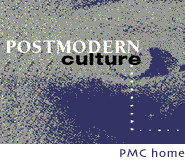
Abstracts
Volume 16, Number 3May, 2006
- Abstract: This essay calls into question the opposition between global capitalist economic, cultural, and social networks and modernity's industrial capitalist social spaces, an opposition between the "space of flows" and the "space of places," as it is developed in Manuel Castells'sthoroughgoing analysis of the information economy. Putting Castells's insights to cross-purposes, the essay foregrounds troubling continuities and collaboration between these divergent social spaces. The essay reads Leslie Marmon Silko's novel Almanac of the Dead for its critical reflection on global capitalist networks and examines its spatio-temporal mapping of the Americas, which implicates these purportedly novel, deterritorialized spatial networks in a five hundred year system of colonial and imperial expansion. The novel's spatio-temporal mapping of the Americas rethinks the socio-spatial logics informing global capitalist networks in light of these continuities, identifying a resistant potential within them. Its counternetworks take advantage of global capitalism's dismantling of the three worlds system, developing a transnational, subaltern model of resistance that refuses both a nationalist, essentialist conception of identity grounded in place and a liberal multicultural identity politics encouraged by global capitalism's "space of flows." --ls
- Abstract: "Queer Optimism" argues that queer theory's attachment to a vocabulary of melancholy, self-shattering, shame, and the death drive precludes a potentially more rigorous and generative understanding of queery theory and of optimism. Through critiques of Butler, Bersani, Sedgwick and Edelman, "Queer Optimism" notes exemplary moments of "queer pessimism," and insists upon a non-Leibnizian optimistic field temporally located beyond the futural, and solicitous of (rather than allergic to) meticulous, vigorous thought.--ms
- Abstract: This essay investigates why "ontology" has become an increasingly important topic for a number of contemporary political philosophers. It is divided into two parts, the first of which contrasts what it calls "neo-left" thinkers with more traditionally minded Marxists (such as Theodor Adorno and Fredric Jameson), focusing in particular on their different understanding of the meaning of "ontology." The second part provides a comparative commentary on Ernesto Laclau, Slavoj Zizek, Alain Badiou, Antonio Negri and Michael Hardt, as well on Giorgio Agamben, in order to analyze their use of and reference to "ontology" as a crucial concept for much leftist political discourse today. Here the focus lies on three interrelated categories: "space," "political acts," and "subject(ivity)." The ontological neo-left faces two basic options: either to adopt a discursive ontology structured around the void (Derrida, Laclau, Mouffe, Badiou, Zizek) or a biopolitical ontology that embraces the productivity of life (Foucault, Deleuze, Agamben, Hardt and Negri). --cs
- Abstract: In October of 2002, the Blur building of the architectural team Diller+Scofidio opened in Switzerland to nearly universal acclaim. The "building"--a cloud manufactured by a nozzle-laced tensegrity structure hovering over Lake Neuchatel--audaciously rethinks architecture as "the making of nothing" (to use the architects' words). This dematerialization of the architectural medium raises all sorts of interesting questions about the concept and function of form in architecture (and in art more generally)--questions that Diller+Scofidio mobilize in relation to the dynamics of spectacle in mass media society. This essay uses the work of systems theorist Niklas Luhmann to understand the central paradox of the Blur project: that the "weakness" of its formal intervention as an object is precisely its strength when form is understood in more abstract terms. This relentless but necessary abstraction of the concept of form in art helps us gain some distance on the more or less conventionally "romantic" associations that the project invites--associations that Diller+Scofidio rightly insist have no place in understanding the project's conceptual underpinnings. And it also helps us grasp how the project deploys and redirects certain modes of visuality that are taken for granted by mass media society and its apotheosis in the society of spectacle--modes that the project itself "blurs," and not without ethical and political implications. --cw
Laura Shackelford, "The Resistance of Counter-Networks in Leslie Marmon Silko's Almanac of the Dead"
Michael Snediker, "Queer Optimism"
Carsten Strathausen, "A Critique of Neo-Left Ontology"
Cary Wolfe, "Lose the Building: Systems Theory, Architecture, and Diller+Scofidio's Blur"
Copyright © 2006-1990 Postmodern Culture & the Johns Hopkins University Press. CONTENTS OF THIS ISSUE ARE AVAILABLE FREE OF CHARGE UNTIL RELEASE OF THE NEXT ISSUE. A TEXT-ONLY ARCHIVE OF THE JOURNAL IS ALSO AVAILABLE FREE OF CHARGE. FOR FULL HYPERTEXT ACCESS TO BACK ISSUES, SEARCH UTILITIES, AND OTHER VALUABLE FEATURES, YOU OR YOUR INSTITUTION MAY SUBSCRIBE TO PROJECT MUSE, THE ON-LINE JOURNALS PROJECT OF THE JOHNS HOPKINS UNIVERSITY PRESS.
